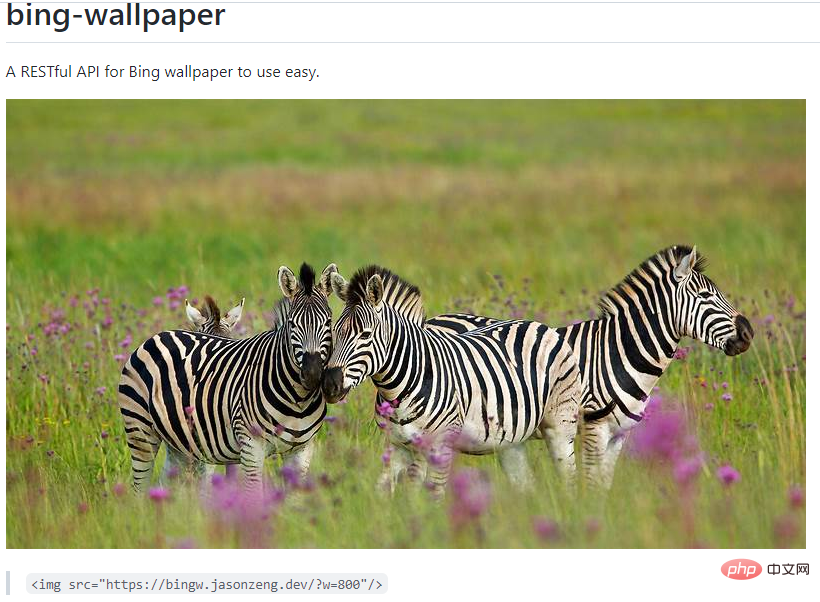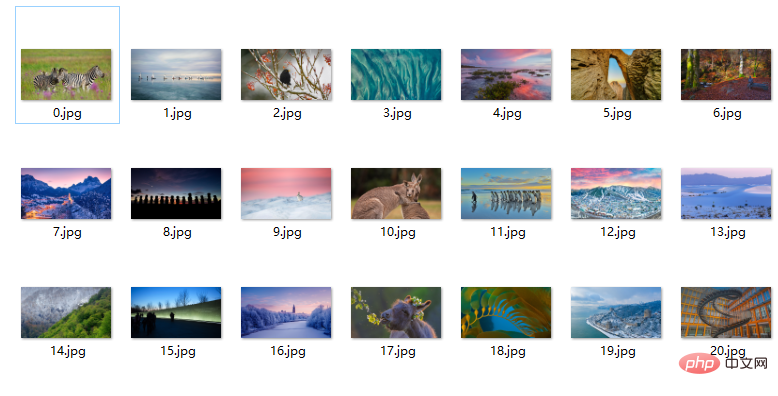 Backend Development
Backend Development
 Python Tutorial
Python Tutorial
 Use Python to download wallpapers and automatically change the desktop
Use Python to download wallpapers and automatically change the desktop
Use Python to download wallpapers and automatically change the desktop
Wallpaper API
We use an open source Bing Wallpaper API on GitHub as the source of wallpaper
https://github. com/zenghongtu/bing-wallpaper

From the readme we can know that in the web application I only need to use the following reference
<img src="/static/imghw/default1.png" data-src="https://img.php.cn/" class="lazy"/ alt="Use Python to download wallpapers and automatically change the desktop" >
It’s so convenient
Interface usage
Let’s take a look at the specific calling rules of the API
1. Incoming The resolution parameter specifies the resolution of the wallpaper image. The default is 1920x1080, the optional values are as follows:
UHD 1920x1200 1920x1080 1366x768 1280x768 1024x768 800x600 800x480 768x1280 720x1280 640x480 480x800 400x240 320x240 240x320
UHD means high definition, and the picture is larger.
2. Pass in index to get pictures of a certain day, 0 means today, 1 means yesterday, and so on, index=random means a random day.
3. Pass in date to get pictures from a certain day to today, such as data=20210401.
4. Pass in w and h to specify the width and height of the image.
5. Pass in qlt to specify the quality of the image, the value range is 0 to 100.
For example
We enter the following address directly into the browser
http://bingw.jasonzeng.dev?resolutinotallow=UHD&index=random&w=1000&format=json
Output:
{
"startdate": "20220105",
"copyright": "Plate-billed mountain toucan in Bellavista Cloud Forest Reserve, Ecuador (© Tui De Roy/Minden Pictures)",
"urlbase": "/th?id=OHR.MountainToucan_EN-US7120632569",
"title": "A plate-billed mountain toucan",
"url": "https://www.bing.com/th?id=OHR.MountainToucan_EN-US7120632569_UHD.jpg&w=1000"
}It can be said to be quite convenient
You can also use it directly in css
background-image: url(https://bingw.jasonzeng.dev/?index=random); height: 100%; background-position: center; background-repeat: no-repeat; background-size: cover;
Python call
Let’s take a look at how to call it through Python, it is also very simple
import requests
def get_wallpaper():
for i in range(30):
url = "https://bingw.jasonzeng.dev?resolutinotallow=UHD&index=%s" % str(i)
print(url)
res = requests.get(url)
with open("wallpaper/" + "%s.jpg" % str(i),"wb") as w:
w.write(res.content)
if __name__ == "__main__":
get_wallpaper()The above code is to get the first 30 pictures For wallpapers, we can modify the range parameters to obtain different numbers of wallpapers
The capture effect is as follows:

Change desktop
Wallpaper With that, let’s automatically switch the desktop wallpaper. Here we use win32con and win32gui to operate the desktop wallpaper
def windows_img(paper_path): k = win32api.RegOpenKeyEx(win32con.HKEY_CURRENT_USER,"Control panel\Desktop", 0, win32con.KEY_SET_VALUE) # 在注册表中写入属性值 win32api.RegSetValueEx(k, "wapaperStyle", 0, win32con.REG_SZ,"2")# 0 代表桌面居中 2 代表拉伸桌面 win32api.RegSetValueEx(k, "Tilewallpaper", 0, win32con.REG_SZ,"0") win32gui.SystemParametersInfo(win32con.SPI_SETDESKWALLPAPER, paper_path, win32con.SPIF_SENDWININICHANGE) # 刷新桌面
and then select the picture from the downloaded wallpaper
def change_wallpaper():
pic_list = os.listdir("wallpaper")# 得到文件路径下的Use Python to download wallpapers and automatically change the desktop,列表类型
i=0
print(pic_list)
while True:
pic = "wallpaper"+'{}'.format(pic_list[i])
abspath_pic = os.path.abspath(pic)
windows_img(abspath_pic)
print(abspath_pic)
time.sleep(1000)# 设置壁纸更换间隔
i += 1
if i==len(pic_list):# 如果是最后一张Use Python to download wallpapers and automatically change the desktop,则重新到第一张
i=0
if __name__ == '__main__':
change_wallpaper()Such a simple automatic The tool for switching desktop wallpaper is complete, come and try it!
The above is the detailed content of Use Python to download wallpapers and automatically change the desktop. For more information, please follow other related articles on the PHP Chinese website!

Hot AI Tools

Undresser.AI Undress
AI-powered app for creating realistic nude photos

AI Clothes Remover
Online AI tool for removing clothes from photos.

Undress AI Tool
Undress images for free

Clothoff.io
AI clothes remover

AI Hentai Generator
Generate AI Hentai for free.

Hot Article

Hot Tools

Notepad++7.3.1
Easy-to-use and free code editor

SublimeText3 Chinese version
Chinese version, very easy to use

Zend Studio 13.0.1
Powerful PHP integrated development environment

Dreamweaver CS6
Visual web development tools

SublimeText3 Mac version
God-level code editing software (SublimeText3)

Hot Topics
 How to convert XML files to PDF on your phone?
Apr 02, 2025 pm 10:12 PM
How to convert XML files to PDF on your phone?
Apr 02, 2025 pm 10:12 PM
It is impossible to complete XML to PDF conversion directly on your phone with a single application. It is necessary to use cloud services, which can be achieved through two steps: 1. Convert XML to PDF in the cloud, 2. Access or download the converted PDF file on the mobile phone.
 What is the function of C language sum?
Apr 03, 2025 pm 02:21 PM
What is the function of C language sum?
Apr 03, 2025 pm 02:21 PM
There is no built-in sum function in C language, so it needs to be written by yourself. Sum can be achieved by traversing the array and accumulating elements: Loop version: Sum is calculated using for loop and array length. Pointer version: Use pointers to point to array elements, and efficient summing is achieved through self-increment pointers. Dynamically allocate array version: Dynamically allocate arrays and manage memory yourself, ensuring that allocated memory is freed to prevent memory leaks.
 How to convert xml into pictures
Apr 03, 2025 am 07:39 AM
How to convert xml into pictures
Apr 03, 2025 am 07:39 AM
XML can be converted to images by using an XSLT converter or image library. XSLT Converter: Use an XSLT processor and stylesheet to convert XML to images. Image Library: Use libraries such as PIL or ImageMagick to create images from XML data, such as drawing shapes and text.
 How to convert XML to PDF on your phone?
Apr 02, 2025 pm 10:18 PM
How to convert XML to PDF on your phone?
Apr 02, 2025 pm 10:18 PM
It is not easy to convert XML to PDF directly on your phone, but it can be achieved with the help of cloud services. It is recommended to use a lightweight mobile app to upload XML files and receive generated PDFs, and convert them with cloud APIs. Cloud APIs use serverless computing services, and choosing the right platform is crucial. Complexity, error handling, security, and optimization strategies need to be considered when handling XML parsing and PDF generation. The entire process requires the front-end app and the back-end API to work together, and it requires some understanding of a variety of technologies.
 How to convert xml to json
Apr 03, 2025 am 08:06 AM
How to convert xml to json
Apr 03, 2025 am 08:06 AM
The steps to convert XML to JSON are as follows: 1. Parses XML data and creates an XML tree structure. 2. Create an empty JSON object. 3. Recursively traverse the XML tree and create corresponding JSON attributes for each node. 4. Process nested elements and create nested JSON objects. 5. Format JSON data using the JSON parser.
 Apr 03, 2025 am 08:12 AM
Apr 03, 2025 am 08:12 AM
XML data modification can be done manually or using programming languages and libraries. Manual modifications are suitable for small amounts of modifications to small documents, including adding, modifying, or deleting elements and attributes. For more complex modifications, programming languages and libraries such as Python's xml.dom and Java's javax.xml.parsers, which provide tools for processing XML data. When modifying XML data, ensure its validity, create backups, and follow XML syntax rules, including the correct tags and properties.
 How to change the format of xml
Apr 03, 2025 am 08:42 AM
How to change the format of xml
Apr 03, 2025 am 08:42 AM
There are several ways to modify XML formats: manually editing with a text editor such as Notepad; automatically formatting with online or desktop XML formatting tools such as XMLbeautifier; define conversion rules using XML conversion tools such as XSLT; or parse and operate using programming languages such as Python. Be careful when modifying and back up the original files.
 How to convert xml into word
Apr 03, 2025 am 08:15 AM
How to convert xml into word
Apr 03, 2025 am 08:15 AM
There are three ways to convert XML to Word: use Microsoft Word, use an XML converter, or use a programming language.





